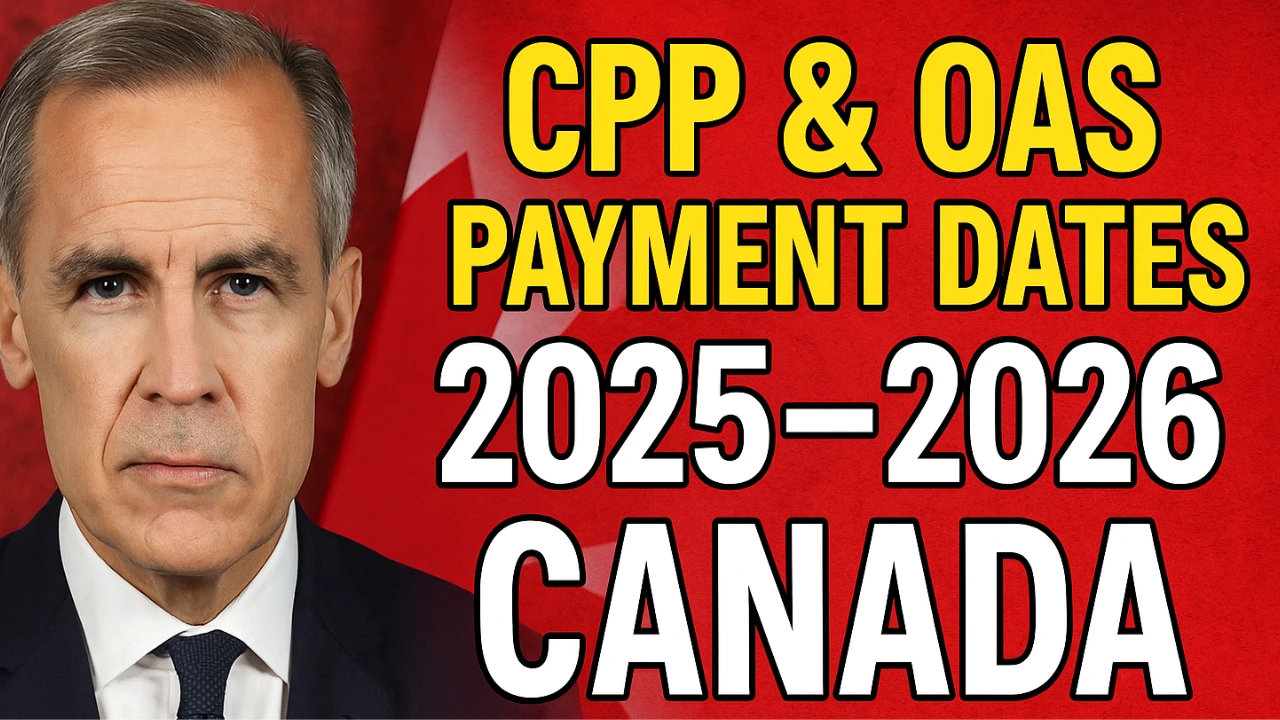The 2025–2026 period is shaping up as one of the most significant years for older Canadians relying on the Canada Pension Plan (CPP) and Old Age Security (OAS). While monthly increases may appear modest, underlying structural changes are reshaping how retirement income works. Seniors can expect new payment schedules, continued rollout of the CPP enhancement, adjustments to OAS based on inflation, and administrative updates that affect when and how payments arrive.
For many retirees, these monthly deposits are the backbone of their financial stability. Even slight shifts — such as a change in deposit day, a revised cost-of-living adjustment, or new income thresholds — can determine whether bills are paid on time, whether GIS eligibility is affected, or whether a retiree faces an unexpected OAS recovery tax later.
With the full schedule for 2025–2026 finalized, seniors now have clarity on exactly when funds will arrive and what changes will influence their budgets during the next 18 months.
Understanding CPP and OAS: the foundation of retirement income
CPP and OAS form Canada’s two major public retirement pillars. CPP is contribution-based: workers and employers pay into the plan throughout their career, and the final pension is determined by years of contributions, average earnings, and the age chosen to start the pension. Anyone can begin CPP as early as age 60 at a reduced rate or delay up to age 70 for an increased rate.
OAS is residency-based. It requires at least 10 years of residence in Canada after age 18 for partial benefits and 40 years for the maximum benefit. The program is funded through general government revenues and is adjusted quarterly to reflect changes in the cost of living. OAS is also subject to the recovery tax, commonly called the “clawback,” applied to higher-income seniors once they pass a specific annual income threshold.
Both programs are adjusted over time to reflect economic conditions and demographic realities, and the 2025–2026 cycle brings several new dynamics for seniors.
Payment dates for CPP and OAS in 2025–2026
The federal payment calendar has confirmed the monthly deposit dates for CPP and OAS for 2025 and 2026. Knowing these dates is essential for budgeting, especially for seniors who time rent, prescription refills, insurance premiums, and grocery expenses around the arrival of their pension.
Generally, CPP is paid on the last Wednesday of the month, while OAS follows the same federal payment cycle. If the scheduled date falls on a weekend or holiday, payments are advanced to the nearest business day.
Complete Payment Schedule for 2025–2026
| Year | Month | CPP Payment Date | OAS Payment Date |
|---|---|---|---|
| 2025 | January | January 29, 2025 | January 29, 2025 |
| 2025 | February | February 26, 2025 | February 26, 2025 |
| 2025 | March | March 27, 2025 | March 27, 2025 |
| 2025 | April | April 28, 2025 | April 28, 2025 |
| 2025 | May | May 28, 2025 | May 28, 2025 |
| 2025 | June | June 26, 2025 | June 26, 2025 |
| 2025 | July | July 29, 2025 | July 29, 2025 |
| 2025 | August | August 27, 2025 | August 27, 2025 |
| 2025 | September | September 26, 2025 | September 26, 2025 |
| 2025 | October | October 29, 2025 | October 29, 2025 |
| 2025 | November | November 26, 2025 | November 26, 2025 |
| 2025 | December | December 23, 2025 | December 23, 2025 |
| 2026 | January | January 28, 2026 | January 28, 2026 |
| 2026 | February | February 25, 2026 | February 25, 2026 |
| 2026 | March | March 27, 2026 | March 27, 2026 |
| 2026 | April | April 28, 2026 | April 28, 2026 |
| 2026 | May | May 27, 2026 | May 27, 2026 |
| 2026 | June | June 26, 2026 | June 26, 2026 |
| 2026 | July | July 29, 2026 | July 29, 2026 |
| 2026 | August | August 27, 2026 | August 27, 2026 |
| 2026 | September | September 25, 2026 | September 25, 2026 |
| 2026 | October | October 28, 2026 | October 28, 2026 |
| 2026 | November | November 26, 2026 | November 26, 2026 |
| 2026 | December | December 22, 2026 | December 22, 2026 |
Two dates stand out:
-
December 23, 2025 and December 22, 2026 are early payments due to holiday schedules.
-
Seniors relying on end-of-month cash flow will need to plan for early December deposits arriving several days sooner than usual.
Benefit amounts for 2025 and expected updates for 2026
While payment dates are crucial, seniors also want to know: How much will I receive?
In 2025, average and maximum CPP and OAS amounts were adjusted to reflect inflation and wage growth. The CPP enhancement, now in its sixth phase, also continues to gradually increase the maximum possible benefit for those who contributed after 2019.
CPP Retirement Pension Amounts (2025)
| Type of Amount | Monthly Value (2025) |
|---|---|
| Maximum CPP pension at 65 | $1,433.00 |
| Average CPP pension at 65 | Around $850 |
| Maximum survivor benefit (under 65) | Around $800 |
| Maximum survivor benefit (over 65) | Around $720 |
Most retirees receive below the maximum, because few contribute the maximum amount for the required 39 years.
OAS Monthly Amounts (2025)
OAS is adjusted every three months to align with inflation. For 2025:
| Age Group | Monthly OAS Amount |
|---|---|
| Ages 65–74 | Around $728 |
| Ages 75 and older | Higher boosted rate introduced in 2022 |
The boost for those 75+ reflects increased longevity and the higher health-care and living expenses faced by this age group.
GIS Supplements
Low-income seniors may qualify for the Guaranteed Income Supplement (GIS), which is income-tested and recalculated annually. With inflation rising in recent years, more seniors are prioritizing GIS eligibility planning to maintain access to these monthly top-ups.
How the 2025–2026 Cost of Living Adjustments affect seniors
Both CPP and OAS are indexed annually or quarterly:
-
CPP adjusts once per year in January.
-
OAS adjusts every three months.
This means seniors may see multiple small increases in OAS payments throughout 2025–2026. While each COLA raise may be small — often less than one percent — they accumulate across the year and help counter rising costs for food, housing, transportation, and medications.
For example:
-
A one-percent increase on a $1,400 CPP pension equals $14 more monthly.
-
A one-percent increase on a $730 OAS payment gives about $7 extra monthly.
These may not seem large, but combined with provincial programs, GIS supplements, and tax credits, they can make a noticeable difference.
The continued rollout of the CPP enhancement
The CPP enhancement is one of the biggest long-term changes to Canada’s retirement landscape. It began in 2019 and will continue phasing in until 2025 and beyond.
What the enhancement means for seniors now
For current retirees:
-
It does not increase pensions earned before 2019.
-
It can slightly increase total household retirement income if a spouse continues contributing at enhanced rates.
For near-retirees still working:
-
The enhancement raises the pensionable earnings limit.
-
Higher contributions today result in higher retirement income tomorrow.
For younger workers:
-
Lifetime retirement benefits will be significantly higher than the pre-2019 CPP structure could provide.
Practical implications
Seniors deciding when to start CPP must consider:
-
Enhanced contributions may make delaying CPP more beneficial.
-
Retiring early may reduce the enhanced portion of the benefit.
Financial planners increasingly advise re-running retirement numbers using enhanced CPP models, especially for retiree households with mixed employment levels.
Administrative and policy changes in 2025–2026 seniors must monitor
Beyond indexing and enhancement effects, several additional policy and administrative developments are shaping the 2025–2026 period.
Direct deposit upgrades
The government is modernizing payment systems across Service Canada. Seniors should ensure:
-
The correct bank account is on file
-
They have updated address and personal identification details
-
They check email or mail for notices requiring verification
Even small administrative mismatches can delay payments for weeks.
OAS threshold and recovery tax adjustments
Higher-income seniors must watch out for the annually adjusted income thresholds for OAS recovery tax. If net income exceeds the threshold:
-
OAS is partially reduced
-
In higher ranges, OAS is fully clawed back
-
Large RRIF withdrawals in December can unexpectedly trigger clawback
Tax planning has become essential for retirees with RRSPs, rental property income, dividends, or capital gains.
Potential provincial and federal top-ups
Some provinces adjust senior tax credits in tandem with inflation. Seniors receiving OAS and CPP should monitor:
-
Property tax credits
-
Provincial inflation relief payments
-
Energy affordability benefits
-
Provincial prescription-drug program income limits
These supports change frequently and can significantly affect annual budgets.
How cash-flow timing affects seniors during 2025–2026
Payment dates matter more than most people realize. A deposit arriving even a few days earlier or later can influence a senior’s ability to manage:
-
Rent and mortgage payments
-
Prescription renewals
-
Scheduled debt payments
-
Grocery allowances
-
Heating and cooling costs
-
Credit-card due dates
The December payment being advanced in both 2025 and 2026 means seniors should create a plan for holiday-month spending, ensuring the early deposit lasts until the end of the month.
Budgeting and tax-planning impacts for seniors
Avoiding OAS clawback surprises
The OAS recovery tax hits when income exceeds the federal threshold. Seniors approaching the limit should consider:
-
Reducing RRIF withdrawals
-
Splitting pension income
-
Selling investments gradually rather than in one large sale
-
Spreading capital gains strategically
-
Using Tax-Free Savings Accounts to generate non-taxable income
GIS eligibility planning
For low-income seniors, even an unexpected $200 bump in annual taxable income can reduce GIS entitlements. Careful planning around:
-
RRSP withdrawals
-
Part-time work
-
Taxable investment income
-
One-time lump sums, such as insurance payouts
can protect access to GIS.
Coordinating CPP and OAS with employer pensions
Some employer pensions reduce benefits when CPP begins. Seniors considering CPP at 60, 65, or 70 should examine how the timing affects those supplementary plans.
Preparation guide: what seniors should do now
Review direct deposit details
Confirm banking information to avoid delays. A surprising number of payment issues stem from outdated bank accounts after switching institutions.
Mark every payment date
Print the 2025–2026 calendar or save it on a smartphone. Setting reminders three days before each payment helps with planning.
Recalculate your withdrawal strategy
For those with RRSPs, RRIFs, or investment portfolios, annual reassessment is crucial. Small changes can avoid thousands in clawbacks.
Check for eligibility under provincial senior programs
Benefits vary widely across provinces. Updated income thresholds can provide support for utilities, medications, dental care, and local property taxes.
Talk to a financial planner or tax specialist
Retirement income is increasingly complex — especially with the CPP enhancement and shifting OAS thresholds. A short consultation can help avoid major mistakes.
Final reflections: what the next decade holds for seniors
The 2025–2026 cycle is more than a routine update. It represents the merging of several major forces:
-
Rising life expectancy
-
Higher cost of living
-
CPP enhancement reforms
-
Income-tested OAS rules
-
Provincial cost-relief programs
-
Increasing reliance on digital government systems
For seniors, this means staying informed is no longer optional — it’s essential.
The good news is that federal payment calendars are now published well in advance, giving retirees a predictable structure for the year. Combined with smart planning and awareness of policy updates, seniors can enter 2025–2026 with confidence and clarity.







Leave a Comment